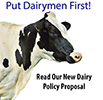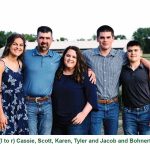Going High Tech
By Denice Rackley
From the road, Wendlandt Farms of Paynesville, Minnesota looks like a typical farm with crop fields and covered barns for cattle. But step through the door of the new slat barn built in 2022 and you just might run into Victor. Victor isn’t a person, a steer, or even a dog – it’s a Lely Vector robot that feeds cattle.
How do you decide to invest in technology that enables you to feed cattle with a robot? Let’s take a step back and look at the operation run by brothers Mike and Troy Wendlandt, Troy’s wife, Ashley Wendlandt, and sister Jennifer and her husband, Bill Albrecht.
The Wendlandts grew up on a fourth-generation crop and cattle farm in Paynesville. Their dad, Tom Wendlandt, worked as an agronomist and continues to farm. The brothers decided to look for a bit of land for themselves near their home farm.
As luck would have it – Mike and Troy acquired older dairy farms across the road from each other in 2014 and 2015. They decided to raise some calves, develop a small beef herd and feed dairy steers to utilize the existing facilities and bring in some extra money. Troy works in HVAC construction, and Mike worked as an applicator for a co-op, a factory night manager and a welder, all to gain skills that would translate into a successful cattle venture.
The Wendlandt brothers first bought a handful of weaned beef calves from a neighbor with the plan of fattening the steers and developing the heifers into a small cow-calf herd. Adding to their home-raised calves, they began buying additional calves to finish.
In 2018, the brothers had an opportunity to purchase another dairy facility with nice crop ground. With their brother-in-law, Bill, already spending time helping out, the three decided to go all in – forming a partnership in Wendlandt Farms LLC. Mike became the onsite full-time manager.
Integrating and Stacking Technologies To Feed Cattle
Upgrading the dairy barn on the new site into a calf facility, they invested in Biotic Enterprise’s ID-TEK automatic calf milk feeding system. The system enables calves to be group housed while the ID-Tek mixes the milk and reads the calves electronic identification tags. The system allows each calf access to only the appropriate amount of milk and records consumption information.
Beginning their cattle business with a handful of calves grown into a beef herd, fattening an ever-increasing number of steers, and raising 80 Holstein bottle calves, incorporating technology has helped with record keeping. “While reading each EID tag slows down processing calves, the information that is gained is well worth it,” said Wendlandt.
Maintaining cattle at the peak of health and performance while saving time, decreasing the amount of labor and increasing the economic sustainability of the operation have been the desired outcome of each and every decision.

Useful Data From Integrated Tech
As more cattle have been purchased, more technology has been added, enabling the collection of hard data that is used to fine-tune management choices. “Incorporating cattle management software from Performance Livestock Analytics allows us to keep everything in one place,” Mike Wendlandt explained.
The tracking system is integrated with their handling and feed systems to give them data on individuals and pens of animals. “Currently, we are mainly interested in tracking animal health records, costs, and pen performance. This system can break down the cost of gain that we correlate back to kill sheets, giving us useful information over the entire span of time the animals are with us. Eventually, we would like to match sire groups with performance data enabling us to identify those calves that might have a genetic edge converting feed to pounds,” Wendlandt said.
Calves are fattened on mostly home-grown feeds in monoslope barns and outside lots. Cattle are fed a total mixed ration (TMR) of corn snaplage, roughage, distillers grain and conventional or liquid protein. “Much of the ration is shell corn with small grains and hay from our meadows. We work with two main lines of products and two great nutritionists,” Wendlandt said.
Working with two nutritionists enables two perspectives offering the Wendlandts twice as much insight and experience on which to base decisions. The two different lines of products add additional flexibility if there are supply line shortages or other complications.
The entire operation is designed to optimize animal health and ensure the safety of cattle and people, with only one person needed for the day-to-day management. But Wendlandt notes that two people working increases efficiency.
The cattle are sourced locally and from afar. “We have purchased calves from Montana, but most come from the east – New York, Pennsylvania, Indiana and Wisconsin,” Wendlandt explained. Ideally, every week to 10 days, finished cattle are shipped out, and once a month a pot load comes in.
The Wendlandts bought their very first pot load of calves through the National Farmers Organization. Now they rely on their National Farmers reps, Steve Eveslage and Bob Hendrickson, to assist them with sale contracts and shipping. “Working with NFO and our reps has given us the confidence that there are opportunities to support our expansion. We appreciate NFO’s support, the flexibility is great and their help has made everything easier,” Wendlandt said.

Expanding The Operation By Marrying New Facilities and Technology
With the spring of 2022 came another expansion. After a ton of research and touring other operations, plans were drawn and construction began on a new Hanson slat finishing barn lined with anti-slip mats that doesn’t require bedding and a manure pit equipped with Dairypower Smart Slurry aerations system to continuously mix the pit and ensure air quality within the barn. A Lely robotic feeder takes over the daily duties of mixing and doling out feed was also part of the planning.
The facility is 105-foot wide by 290-foot long, has nine pens, an Arrowquip hydraulic chute with a bud box and double alleyway with a charging station for the robot. There are eight slat pens, with one pen serving as a special needs pen to address everything from holding incoming cattle and loading out cattle, to cattle that need special attention.
By the fall of 2022, the new barn was complete and the Lely Vector automatic feeding system was in use. This system loads, mixes, feeds, pushes feed up to the bunks and sweeps alleyways. The charging station doubles as a staging area where feed ingredients are stored. This ‘kitchen’ has a crane/grabber for roughage and augers that load the robotic TMR. With the ration programmed into the computer, each ingredient is weighed, added and mixed. Then feeding begins. Knowing where to go to feed what ration, there is an onboard guidance system that continually coordinates the robots’ location with special strips added to the floor during construction.
The robot — named Victor, moves down the lane, identifying the pen by location, scans the feed height, and sweeps feed toward the bunk. If the feed is below a certain height, Victor will go to the kitchen and mix the appropriate ration for that pen, deliver it, and calculate its next priority. In essence, the cattle are able to dictate how much food they have available.
Currently, Victor is mixing and feeding two distinctly different main rations along with slightly different transitional rations. Victor works 24×7, so the only limiting factor is time and availability of ingredients. With the new barn at 8oo head, Wendlandt figures Victor is saving him four hours each day, although he says filling the kitchen requires an hour each day.
“With the expansion in a traditional feeding system, we would have needed to upgrade our tractor and TMR and still would have the added labor of feeding, ” Wendlandt explained “Considering the time and labor savings, the Vector system is very cost-effective.”
With a year into the new barn and using the robotic feeding system, they are gathering hard numbers to study animal health impacts and the return on investment.
Wendlandt said the cattle are more relaxed and are up eating throughout the day. “Victor keeps fresh feed in front of the steers 24 x 7, so not every individual feels the need to be eating at each pass like they would in a traditional feeding system.” The cattle snacking all day long could result in better rumen health. “I think we will find cattle health has improved a bit and the cost per gain is lower,” Wendlandt noted.

Vision For the Future
Beginning with calves that grew into a beef herd and fat steers, to dipping their toes into raising dairy bottle calves, and now seven years later, finishing 1300 head of Holstein and dairy cross calves on five different sites, Wendlandt Farms has grown exponentially. “It’s a bit of a juggling act,” Wendlandt said. However, he is eager to see where this path leads. “We hope to feed more cattle more efficiently,” Wendlandt said.
Looking to optimize every opportunity that comes their way, Mike, Troy, and Bill are unafraid to do things a bit differently and explore new technologies that might give them an advantage. By combining cutting-edge technologies, Wendlandt Farms is moving on up and moving fat cattle on out!










